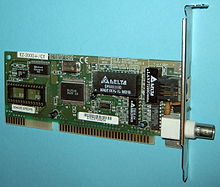NE2000
The NE2000 network card is a 16-bit Ethernet adapter manufactured for Novell by Eagle Technology (later Anthem Technology) and is an open 16-bit ISA bus design for Ethernet cards.
history
Origins
The NE1000 adapter is the 8-bit ISA counterpart; the design of both cards is almost identical and, like the Western Digital WD80x3, 3Com 3c503 and NE1000 cards, is based on the National Semiconductor DP8390 chip. From July 1988 the NE2000 cards were offered for 495 USD , at the same time as the model for the microchannel bus NE / 2. As early as June 1989, the price was lowered to 345 USD.
Novell made both designs openly available with the intention of motivating as many card manufacturers as possible to build such cards. In the design, attention was paid to low manufacturing costs, so separate processors and additional memory (RAM) were specifically avoided in order to keep costs low. This lowered the entry-level prices for Ethernet cards, especially in order to open up further markets for Novell Netware -based networks.
NE2000 and its successors
NE2000 and compatible Ethernet cards dominated the 16-bit ISA market, despite some design imperfections. For the immediately following bus architecture, Extended ISA (EISA), there were NE3200 cards that differed significantly in terms of construction. Only with the introduction of PCI systems did the NE2000-compatible cards experience a renaissance, especially in the low-end area, although these cards cannot actually work with original NE2000 drivers - they just have a similarly simple design.
Reasons for success
The success was based on three main pillars: a good functionality, the open design and the low price. The performance is a weak point of the NE2000 cards, but this is only noticed under high load in practice. For this reason, the decision was often made in favor of the NE2000 cards for normal workstation computers, and they were also found in small servers - Novell finally delivered suitable drivers for its Netware servers.
The end of an era
NE2000-compatible ISA cards remained on the market for a very long time, and the introduction of the PCI bus from 1990 only resulted in the complete disappearance of practically all ISA network cards in servers. The development of the Fast Ethernet standard in 1995 changed almost nothing - the technology was initially too expensive. However, when Fast Ethernet distributors such as hubs and switches became more and more popular and, above all, cheaper at the end of the 1990s , the end of the NE2000 ISA cards was heralded. The ISA bus could not transport the data quickly enough for 100BASE-TX networks.
From the beginning of the 2000s, PCI cards from various manufacturers began to appear on the market , almost always with 3Com , AMD , DEC or Intel chipsets. Since these cards were not overpriced, it took a relatively long time before so-called NE2000-compatible 10/100 Mbit cards came onto the market. You reach 2006 - e.g. B. with Realtek 8029, Winbond 89C940, Compex RL2000, or Via 86C926 chipset - again considerable popularity in the low-end market segment. The designation NE2000-compatible subsequently lost its former marketing power. In the following years, various network cards from Realtek dominated the small office and home office area.
Individual evidence
- ↑ Archived copy ( Memento of the original from March 4, 2016 in the Internet Archive ) Info: The archive link was inserted automatically and has not yet been checked. Please check the original and archive link according to the instructions and then remove this notice.

